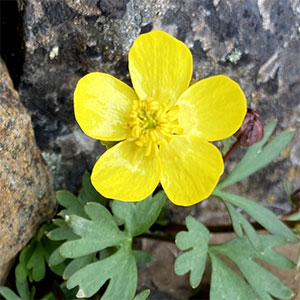Ranunculus basalticus
Ranunculus flammula
basalt buttercup
creeping buttercup, creeping crowfoot, creeping spearwort, greater creeping spearwort, lesser spearwort, lesser water buttercup, spearwort
not thickened basally, glabrous.
erect to prostrate, usually rooting nodally, glabrous or sparsely strigose.
lanceolate to oblanceolate or filiform, 0.7-6.5 × 0.04-1 cm, base acute to filiform, margins entire or serrulate, apex acute to filiform.
bracts lanceolate to oblanceolate.
receptacle glabrous;
sepals 5, spreading or weakly reflexed, 1.5-4 × 1-2 mm, glabrous or appressed-hispid;
petals 5-6, 2.5-7 × 1-4 mm;
nectary scales glabrous.
globose or hemispheric, 2-4 × 3-4 mm;
achenes 1.2-1.6 × 1-1.4 mm, glabrous;
beak lanceolate to linear, straight or curved, 0.1-0.6 mm.
Ranunculus basalticus
Ranunculus flammula
Varieties 3 (3 in the flora).
In Eurasia, this taxon is usually treated as two closely related species. Ranunculus flammula in the strict sense has relatively stout (0.8-3 mm thick) stems that are erect or ascending from prostrate bases, lanceolate to oblanceolate leaves 3-10 mm broad, sepals 3-4 mm, and petals 5-7 × 3-4 mm. Ranunculus reptans has slender (0.2-1 mm thick) stems that are usually prostrate except for the pedicels, leaves linear or filiform, to 2 mm broad, sepals 1-2 mm, and petals 3-5 × 1-2.5 mm. In North America, this distinction holds up relatively well east of the Great Plains, where plants with the characteristics of R. flammula in the strict sense are found in eastern Canada (Newfoundland and northern Nova Scotia) while plants with the characteristics of R. reptans are widespread. In the western part of the continent, however, the situation is much less clear. Collections from the Great Plains and Rocky Mountains resemble R. reptans in most characters, but they often have broader leaves (up to 5 mm broad). Plants from farther west are very confusing; specimens showing the typical morphology of R. flammula in the strict sense and R. reptans are found over a wide area, but most specimens from this area combine the characteristics of the two taxa in various ways. For this reason, it is not possible to separate these taxa at the species level. Three varieties are usually recognized, but further study will probably alter the varietal classification (see comments below, under R. flammula var. ovalis).
(Discussion copyrighted by Flora of North America; reprinted with permission.)
1. Stems erect to prostrate; sepals 3–4 mm; petals 5–7 × 3–4 mm. | var. flammula |
1. Stems prostrate or sometimes ascending; sepals 1–3 mm; petals 3–5 × 1–3 mm. | → 2 |
2. Leaf blades 0.2–0.8 cm wide. | var. ovalis |
2. Leaf blades 0.04–0.1 cm wide. | var. reptans |
- Local floras:
WA
- Local Web sites:
Flora NW,
PNW Herbaria
WildflowerSearch
iNaturalist (observations)
- LBJ Wildflower Center
- SEINet
- Plants of the World Online
- Encyclopedia of Life
- Wikipedia
- Google Image Search
- Local floras:
BC,
CA,
OR,
WA
- Local Web sites:
CalFlora,
CalPhotos,
Flora NW,
Go Botany,
MI Flora,
MN Wildflowers,
PNW Herbaria,
Turner Photog.
WildflowerSearch
iNaturalist (observations)
USDA Plants Database
- LBJ Wildflower Center
- SEINet
- Plants of the World Online
- Encyclopedia of Life
- Wikipedia
- Google Image Search
